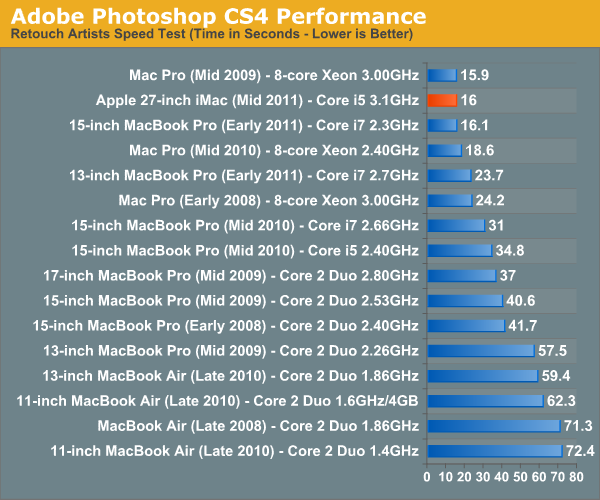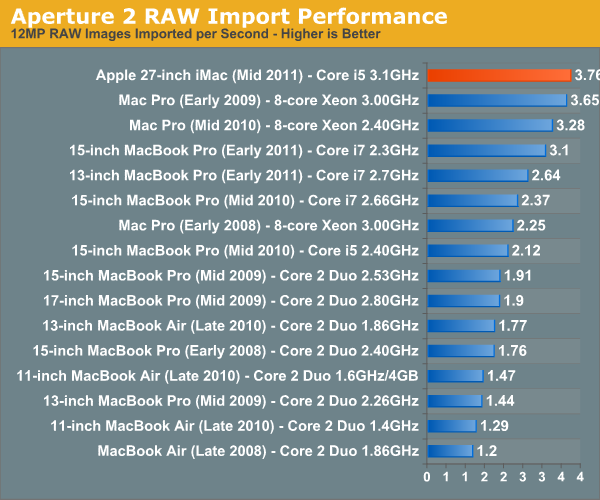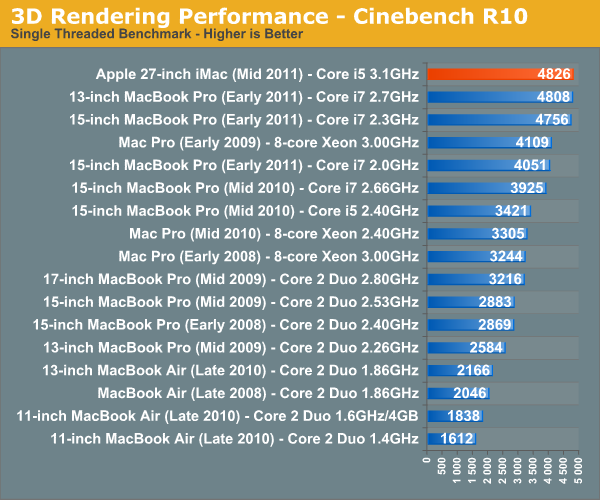The 27-inch Apple iMac Review (2011)
by Anand Lal Shimpi on May 27, 2011 2:30 AM ESTPower, Thermals and Noise
I started this review complaining about how loud the 15-inch MacBook Pro gets, but with 32x the physical volume the 27-inch iMac is near silent. Even under load the system is very quiet, almost too quiet. Apple chose a very lax fan profile which results in some very high external temperatures. The iMac takes in cool air from the bottom of the display and exhausts it up top behind the display. Playing Half Life 2 Episode Two I measured a maximum surface temperature of 125F at the exhaust vent. Again, unless you're doing something weird with the iMac on your lap this isn't an issue. Keep in mind that the Sandy Bridge CPU in the 15-inch MacBook Pro carries a 45W TDP and what's in the iMac is either 65W or 95W. Add in a larger, hotter hard drive and potentially a beefier GPU and you have a recipe for a pretty warm machine.
| 2011 iMac Power Usage | ||||||
| 27-inch iMac (Mid 2011) | Idle | Cinebench R11.5 | Half Life 2 Episode Two | |||
| Minimum Brightness | 54.1W | 108.3W | 149.0W | |||
| 50% Brightness | 86.6W | 141.6W | 180.0W | |||
| 100% Brightness | 144.5W | 198.3W | 240.0W | |||
With a large integrated display power consumption obviously varies depending on brightness. At idle, power consumption ranges from 54W to 144W. Under load the range quickly gets ever higher. I measured max system power consumption at 240W running Half Life 2 Episode Two.
Power consumption isn't out of control but you've got a billion transistor CPU, a 1.7B transistor GPU and a high resolution 27-inch display + backlight - it's going to draw some power.
Performance
Having never previously been a fan of the iMac, I don't actually have any historical performance data to compare to. What I do have however are scores from Mac Pros and of course the MacBook/MacBook Pro lines from the past couple of years.
Adobe Photoshop CS4 Performance
The Retouch Artists Speed Test we use for our CPU testing under Windows also works under OS X. We're running the exact same benchmark here, basically performing a bunch of image manipulations and filters and timing the entire process.

The high-end 27-inch iMac is a very capable Photoshop machine. A hair faster than the new MacBook Pro, the iMac delivers the same performance as an 8-core Mac Pro from 2009 or 2010.
Aperture 2 RAW Import
For my Aperture test I simply timed how long it took to import 203 12MP RAW images into the library.

We have a new winner here! The MacBook Pros were always limited by their slower 2.5" hard drive, but the iMac with Sandy Bridge in additional to a speedier disk give us better image import performance than the '09 and '10 Mac Pros. I told you this thing was fast.
Cinebench R10 & 11.5
I’m a fan of the Cinebench tests because they lets me show off both single and multithreaded performance in the same workload. First, the single threaded performance:


Sandy Bridge quad-core CPUs make no sacrifices. You get excellent single threaded performance which means general OS usage, launching applications and even rendering most web pages happens as fast as physically possible as the other cores are power gated and asleep. Start multitasking however and you'll see the Core i5 in this machine is no slouch:

There's still no replacement for more cores when it comes to heavily threaded applications, the past three years of 8-core Mac Pros are still faster than the new 27-inch iMac here. I suspect the upgraded Core i7 would at least let the iMac beat the 2008 Mac Pro thanks to Hyper Threading, but the other two systems are simply out of reach. For those users, you're better off waiting for the Sandy Bridge-E Mac Pro update expected sometime in Q4.
You'll notice in Cinebench R10 the 15-inch MacBook Pro is nipping at the heels of the new iMac. Chalk that up to the larger L3 cache and Hyper Threading, both advantages enjoyed by the MacBook Pro. Look at what those advantages do in Cinebench R11.5's multithreaded test:

Here the MacBook Pro actually gains on the iMac. More threads and more cache are better suited for the Cinebench workload. If you do a lot of offline 3D rendering and you want the iMac, I'd suggest upgrading to the Core i7-2600 that Apple offers. You get a not insignificant boost in clock speed but more importantly, Intel switches on Hyper Threading which gives you twice as many threads.
Quicktime H.264 Video Encoding
Our final benchmark is more consumer focused. Here I'm taking an XviD and converting it to an iPhone-supported H.264 format.

QuickTime doesn't make tremendous use of all cores all of the time, and thus the MacBook Pro loses its threading advantage. The iMac is our new champion of this test.










139 Comments
View All Comments
dagamer34 - Friday, May 27, 2011 - link
It's a desktop CPU, but a laptop GPU, and it really shows on page 4 when comparing the 6970M against desktop card. When you've spent $2000 on a machine with the same graphical performance as a $160 video card, that's when you REALLY know that Macs are NOT meant for gaming.That's why instead of buying an 27" iMac for gaming, I bought a 27" ACD and built a gaming PC. Same price, but PC parts (especially GPU) are upgradable, and since the computer isn't attached to the monitor, it retains it's value a LOT more.
Penti - Friday, May 27, 2011 - link
I would prefer the Dell U2711 here, as it's about 450 dollars less here in Sweden with Apples fucked up pricing tied to old exchange rate. Neither is it too fun with a 1650 dollar screen with just mini-displayport input. (Of which 25% VAT is included).Kristian Vättö - Friday, May 27, 2011 - link
Not a big deal but I thought I would add them anyway. On first page, you say 15" MBP has AMD 6770M while it really has 6750M. Scroll down to the HD part of the first page and it says the base 21.5" comes with 512GB HD, while it is a 500GB.For anyone who says I'm nitpicking, I'm not. I have written articles myself and I have made typos too. Look at the Ivy Bridge/Panther Point article's comments if you don't believe (I typoed that IB IGP will have OpenCL 10.1 :D). Like I said, it isn't a big deal but personally, I appreciate if someone points out my typos in a friendly matter.
BTW, Anand, you look like the mafia boss of SSDs in the FaceTime pic :D SSDs for every finger.
tipoo - Friday, May 27, 2011 - link
Also on the GPU page, "The entry level 21.5-inch MacBook Pro "...Now that would be an interesting product, lol.awaken688 - Friday, May 27, 2011 - link
"I've always kept displays through several upgrades, but you can't really do that with an iMac. I'm not really sure how to come to terms with that aspect of what Apple is offering here."That is the key statement. You have a nice $1000 monitor, but you have to sell it to upgrade (yeah, you can use it again, but you have a whole computer in the back). So you take depreciation on your hardware and depreciation on your monitor. Then you get another iMac and repeat. In the PC world of desktops, you get a nice monitor and only take depreciation one time on the monitor. Over 3 upgrade cycles, that can be $500-$1000 in savings over the iMac solution depending on the quality of the monitors. That is a big deal. MacBook Pros make perfect sense to me, but Apple just does not offer a desktop model that fits my needs. Mini is too slow and Mac Pro has Xeon cores which I refuse to pay for as I don't need them. I won't hold my breath for Apple to fill in my needs.
Kristian Vättö - Friday, May 27, 2011 - link
Mac Pros just have an extremely fat profit margin, nothing else. Xeon 3000-series CPUs cost as much as their Core iX counterparts. For example the W3530 used in base Mac Pro costs 294$, which is the same as what i7-930 costs. Dell sells a similarly equipped workstation for around 1500$, and yes, that includes Xeons, ECC RAM, workstation GPU (something that MP doesn't have) etc.It's obvious that iMac is Apple's flagship in consumer desktop market. They have shown zero interest towards a mid-tower though why would they? iMac is selling brilliantly.
dagamer34 - Friday, May 27, 2011 - link
At this point, Mac Pros are pretty much in dire need for a price adjustment. Even if you really do need all that power, I think buying it makes you feel silly compared to what is available in the MacBook Pros and iMacs of today. And with Thunderbolt, the biggest reason to buy a Mac Pro has disappeared (high speed i/o cards).Penti - Friday, May 27, 2011 - link
Well when they still where new, the dual processor models where priced competitively against real HP and Dell workstations which often even did cost a bit more. The problem here are two things, the single processor model is just rubbish and priced about 1000 dollars too much (a year ago or even two years ago) and that Apple never adjusts the price of a model but instead replaced them with a new one. With a new price.A single socket Mac pro shouldn't be more then a C i7 2600K for like 1200 dollars now, a extreme edition SNB would cost some additional 700 dollars, dual processor model should use something like Westmere-EX by now. 10-core (6-10C) two socket support and quad-channel memory. Why mess around with LGA2011 or LGA1366 today? They pretty much have no choice but to go real high-end or use normal desktop parts with the Mac Pro update. There are no Sandy-Bridge workstation class processors. And dual 8C Westmere-EX would end up costing something like 6000 dollars for the machine though. There's just no good workstation hardware competitively priced there to begin with right now. Right now it doesn't get better then dual Westmere 2.93GHz as the Mac Pro uses. AMD HD6970, two 8-core Westmere-EX is pretty much as far they could go today/this year and that would end up costing at least above 5000 dollars. Just leaving iMac comfortably under that as workstation. But they probably won't upgrade that until sometime after Lion any way.
KoolAidMan1 - Friday, May 27, 2011 - link
The thing is that depreciation on the iMac is much much slower than it is with PC parts. I sell my iMac and my gaming PC components at roughly the same time, and what I make back selling the old iMac is significantly higher than what I sell my PC parts for.Getting a high resale return on my old 24" iMac and using the proceeds to get a new 27" iMac with that gorgeous display was a great deal, and it actually sold me (I was skeptical too) on the idea of upgrading all-in-ones by selling the whole thing on ebay. Getting a similar return on my PC is just not possible.
tipoo - Friday, May 27, 2011 - link
Does anyone know if the GPU switching is enabled in the iMac's? They didn't mention the HD graphics on the spec page unlike the MBP's, so maybe they didn't bother with it since there is no battery. Also most of them use the HD2000 which is half as powerful as the HD3000, so maybe it didn't meet their requirements even for basic desktop work.